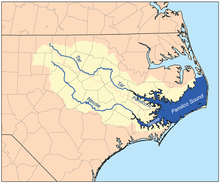Pamlico Sound


Pamlico Sound(/ˈpæmlɪkoʊ/PAM-lik-oh) is a largeestuarinelagooninNorth Carolina.The largest lagoon along theNorth AmericanEast Coast,it extends 80 mi (130 km) long and 15 to 20 miles (24 to 32 km) wide. It is part of a large, interconnected network of similar lagoons that includesAlbemarle Sound,Currituck Sound,Croatan Sound,Roanoke Sound,Pamlico Sound,Bogue Sound,Back Sound,andCore Sound[1][2]known collectively as the Albemarle-Pamlico sound system. With over 3,000 sq. mi. (7,800 km2) of open water[3]the combined estuary is second only in size to 4,479 sq mi (11,600 km2)Chesapeake Bayin the United States.
The Pamlico Sound is separated from theAtlantic Oceanby theOuter Banks,a row of low, sandybarrier islandsthat includeCape Hatteras National Seashore,Cape Lookout National Seashore,andPea Island National Wildlife Refuge.The Albemarle-Pamlico Sound is one of nineteen great waters recognized by the America's Great Waters Coalition.[4]
Hydrology[edit]
Pamlico Sound is connected to thenorthwithAlbemarle Soundthroughpassagesprovided by theRoanoke SoundandCroatan Sound.Core Soundis located at the Pamlico's narrow southern end.[1][2]It is fed by theNeuseandPamlicorivers (the latter of which is theestuaryof theTar River) from the west, and from the east byOregon Inlet,Hatteras Inlet,andOcracoke Inlet,which also provide passage to theAtlantic Ocean.[5]Thesalinityof the sound averages 20ppt,compared to an average coastal salinity of 35 ppt in the Atlantic and 3 ppt in the Currituck Sound, which is located north of the Albemarle Sound.[6]
The sound and its ocean inlets are noted for wide expanses of shallow water and occasionalshoaling,making the area hazardous for larger vessels. While the deepest hole of the estuary (26 ft; 7.9 m) can be found in the Pamlico Sound,[7]depths generally range from 5 to 6 feet (1.5 to 1.8 m).[8]In addition, the shallow waters are susceptible to wind and barometric pressure-driven tidal fluctuations. This effect is amplified on thetributaryrivers, where water levels can change by as much as two feet in three hours when winds are aligned with the rivers' axes and are blowing strongly.[1][2]
History and current use[edit]
In March 1524, Italian ExplorerGiovanni da Verrazzanomistook the sound for thePacific Oceanbecause of its wide expanse and separation from the Atlantic Ocean by the Outer Banks barrier islands.[5]The sound was named for thePamlicothat lived along the sound's mainland banks and who were referred to as the Pamouik by theRaleighexpeditions (circa 1584).[9]
Three locations of Pamlico Sound in theOuter BanksbetweenCape HatterasandCape Fearwere once under serious consideration by theUnited States Atomic Energy Commissionas anatomic bomb testsite during the late 1940s and early 1950s.[10][11]Portions of Pamlico Sound are used as a bombing and training range forCamp Lejeune.[12]
In 1987, Congress declared the Albemarle-Pamlico Sound an "estuary of national significance."[3]For vacationers to the Outer Banks, the Pamlico Sound is a "watersports playground" providing opportunities for fishing and crabbing, boating, kayaking, sailing, windsurfing, kiteboarding, parasailing, paddleboarding, and more.[5]In 2012, the economic impact of tourism to the Albemarle-Pamlico Sound area exceeded $1.3 billion.[3]
The sound also supports local commercial fishing, crabbing, shrimping, clamming, and oystering. 90% of North Carolina's commercial fishing catches are attributed to the Pamlico Sound, generating almost $100 million per year.[13]
Wildlife[edit]
Along the coastal areas are numerouswaterfowlnesting sites, includingPea Island National Wildlife Refugeon the Outer Banks, andSwanquarter National Wildlife Refugeon the mainland.[1][2]Dolphinsandsea turtles[14]are abundant,[15]with occasional visits bysealssuch asharp sealin early January and February. Many othercetaceansincluding rare species such asfin whales,Cuvier's beaked whales,andorcasare present off Outer Banks and Cape Hatteras.Whalessuch asAtlantic gray(now extirpated),[16]North Atlantic right(critically endangered), andNorth Atlantic humpbackwere historically common. Endangered species such asleatherback turtles,[17]whale sharks,andbasking sharksare also known to visit the sound as well.[6]
The sound also sports a variety of fish populations includingred drum,speckled trout,flounder,striped bass(known as rockfish by local populations),croaker,spot,pompano,kingfish,andbluefish.In addition, shellfish populations includingblue crab,shrimp,oysters,andclamsare healthy.[7]
Gallery[edit]
-
A sunset on Pamlico Sound as seen from The Inn on Pamlico Sound inBuxton, North Carolina.
-
Sunset over the Sound just south ofSalvo, North Carolina.
References[edit]
- ^abcd"Albemarle-Pamlico Sound".University of Rhode Island.
- ^abcd"Pamlico Sound".Outer Banks.
- ^abc"NCDEQ - Fast Facts".portal.ncdenr.org.Retrieved2015-09-29.
- ^National Wildlife Federation (August 18, 2010)."America's Great Waters Coalition".Retrieved2011-08-18.
- ^abc"Pamlico Sound - OuterBanks".outerbanks.Retrieved2015-09-29.
- ^abSchwartz J.F.. 2010.BASKING AND WHALE SHARKS OF NORTH CAROLINA.Journal of the North Carolina Academy of Science, 126(3), 2010, pp. 84–87. Retrieved on December 10. 2014
- ^ab"The Albemarle-Pamlico Estuary | Outer Banks Catch".outerbankscatch.Archived fromthe originalon 2015-09-30.Retrieved2015-09-29.
- ^"Pamlico Sound - OuterBanks".outerbanks.Retrieved19 April2018.
- ^"Pamlico Indians | NCpedia".ncpedia.org.Retrieved2015-09-29.
- ^Project NutmegArchived2016-05-05 at theWayback MachineOcracoke Newsletter; (April 21, 2012);Village Craftsman;retrieved: December 12, 2016.
- ^Excerpts from documents and books regarding the decision to locate the test site in Nevada;Retrieved December 10, 2016.
- ^Military releases information on continued exercises going on in area;Retrieved: December 10, 2016.
- ^"North Carolina's blue crab dilemma - Commercial Fishing Data".cmast.ncsu.edu.Retrieved2015-09-29.
- ^Epperly P.S.. Braun J.. Veishlow A.. 1995.Sea Turtles in Noerh Carolina WatersJSTOR2386782.the Conservation Biology Vol. 9, No. 2 (Apr., 1995), pp. 384-394. Retrieved on December 10. 2014
- ^Donnelly M.. 2007.Sea Turtles and North Carolina Inshore FisheriesArchived2014-12-14 at theWayback Machine.VELADOR - the Sea Turtle Conservancy Newspaper. Issue 2 (2007). TheSea Turtle Conservancy.Retrieved on December 10. 2014
- ^Regional Species Extinctions - Examples of regional species extinctions over the last 1000 years and more.Archived2011-04-25 atArchive-It.Retrieved on December 10. 2014
- ^Young N..2006.GUIDELINES FOR DEVELOPING APOTENTIAL BIOLOGICAL REMOVAL (PBR)FRAMEWORK FOR MANAGING SEA TURTLEBYCATCH IN THE PAMLICO SOUNDFLOUNDER GILLNET FISHERY.Master of Environmental Management degree in the Nicholas School of the Environment and Earth Sciences ofDuke University.Retrieved on December 10. 2014

